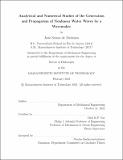Analytical and Numerical Studies of the Generation and Propagation of Nonlinear Water Waves by a Wavemaker
Author(s)
Seixas de Medeiros, João
DownloadThesis PDF (8.431Mb)
Advisor
K.P. Yue, Dick
Terms of use
Metadata
Show full item recordAbstract
The ability to predict the nonlinear effects of extreme wave events is paramount for the preparation of modern experimental tests in large wave basins. Currently, linear theory is routinely used, hence nonlinear wave-wave interactions between propagating waves are often ignored. In addition, the nonlinear interaction between evanescent modes and the generated waves has not been considered. For realistic large wave basins, there is a need for a robust and efficient nonlinear numerical wave tank capable of effectively simulating such nonlinear wave generation and propagation from general wavemaker kinematics. This thesis addresses both issues through new analytical and numerical developments.
We perform a theoretical multiple scales analysis of the nonlinear interaction be- tween a progressive wave and its evanescent modes, deriving a new set of (2 + 𝑁ₑ) partial differential equations (PDEs) that govern their coupled evolution, alongside the appropriate boundary conditions, where 𝑁ₑ is the number of evanescent modes considered. This nonlinear evolution is governed by three dimensionless parameters: (a) wave steepness 𝜖, (b) wave length relative to water depth 𝑘₀h and (c) a newly developed wavemaker parameter 𝜇, which measures the relative importance of evanescent modes at the onset of generation. Through a numerical study of these PDEs, we conclude that evanescent modes cause an increase in amplitude and a phase shift of the progressive wave, and that, for sufficiently high 𝜖 and 𝜇, such nonlinear effects cannot be ignored. We also find that the evanescent modes cause an increase on the progressive phase speed close to the wavemaker.
For realistic large basins, we develop a novel three-dimensional, fast, and robust high-order boundary element method (HBEM) to solve for the general time-history of nonlinear broadband steep waves generated by wavemakers of arbitrary shape. This numerical method uses a new expansion up to order 𝑀 of the free-surface and wavemaker, which demand the calculation of a series of high-order normal derivatives of the velocity potential. To guarantee accuracy and convergence we must: (a) solve for these derivatives in integral form through recursive use of Green third identity, while (b) imposing a 𝐶¹-continuity condition on the velocity potential at the intersection between the free-surface and wavemaker to suppress known singular solutions. We show excellent results up to 𝑀 = 4.
Finally, we use HBEM to solve for the nonlinear evolution of progressive waves due to the presence of evanescent modes, as done in the earlier analytical work. HBEM predicts the same amplitude increase and phase shift of the progressive wave, corroborating the existence of a resonant condition near the wavemaker. We conclude by investigating the importance of the evanescent modes on accurately predicting a nonlinear wave focusing event. We show that the nonlinear wave-wave interactions cause an appreciable shift of the focusing position and a reduction of the wave height during focusing. When evanescent modes nonlinear interactions are included, their effect on the focusing event is comparable to those of the other wave-wave nonlinear interactions.
Date issued
2023-02Department
Massachusetts Institute of Technology. Department of Mechanical EngineeringPublisher
Massachusetts Institute of Technology